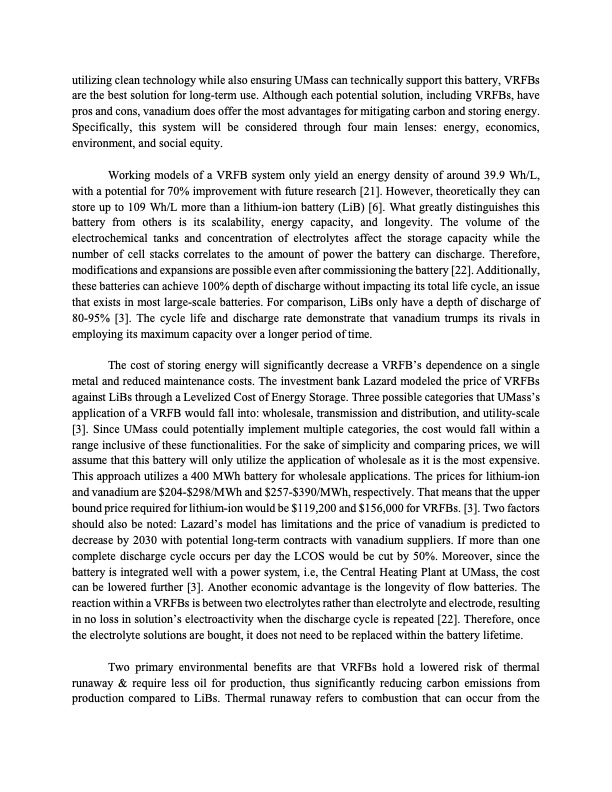
PDF Publication Title:
Text from PDF Page: 007
utilizing clean technology while also ensuring UMass can technically support this battery, VRFBs are the best solution for long-term use. Although each potential solution, including VRFBs, have pros and cons, vanadium does offer the most advantages for mitigating carbon and storing energy. Specifically, this system will be considered through four main lenses: energy, economics, environment, and social equity. Working models of a VRFB system only yield an energy density of around 39.9 Wh/L, with a potential for 70% improvement with future research [21]. However, theoretically they can store up to 109 Wh/L more than a lithium-ion battery (LiB) [6]. What greatly distinguishes this battery from others is its scalability, energy capacity, and longevity. The volume of the electrochemical tanks and concentration of electrolytes affect the storage capacity while the number of cell stacks correlates to the amount of power the battery can discharge. Therefore, modifications and expansions are possible even after commissioning the battery [22]. Additionally, these batteries can achieve 100% depth of discharge without impacting its total life cycle, an issue that exists in most large-scale batteries. For comparison, LiBs only have a depth of discharge of 80-95% [3]. The cycle life and discharge rate demonstrate that vanadium trumps its rivals in employing its maximum capacity over a longer period of time. The cost of storing energy will significantly decrease a VRFB’s dependence on a single metal and reduced maintenance costs. The investment bank Lazard modeled the price of VRFBs against LiBs through a Levelized Cost of Energy Storage. Three possible categories that UMass’s application of a VRFB would fall into: wholesale, transmission and distribution, and utility-scale [3]. Since UMass could potentially implement multiple categories, the cost would fall within a range inclusive of these functionalities. For the sake of simplicity and comparing prices, we will assume that this battery will only utilize the application of wholesale as it is the most expensive. This approach utilizes a 400 MWh battery for wholesale applications. The prices for lithium-ion and vanadium are $204-$298/MWh and $257-$390/MWh, respectively. That means that the upper bound price required for lithium-ion would be $119,200 and $156,000 for VRFBs. [3]. Two factors should also be noted: Lazard’s model has limitations and the price of vanadium is predicted to decrease by 2030 with potential long-term contracts with vanadium suppliers. If more than one complete discharge cycle occurs per day the LCOS would be cut by 50%. Moreover, since the battery is integrated well with a power system, i.e, the Central Heating Plant at UMass, the cost can be lowered further [3]. Another economic advantage is the longevity of flow batteries. The reaction within a VRFBs is between two electrolytes rather than electrolyte and electrode, resulting in no loss in solution’s electroactivity when the discharge cycle is repeated [22]. Therefore, once the electrolyte solutions are bought, it does not need to be replaced within the battery lifetime. Two primary environmental benefits are that VRFBs hold a lowered risk of thermal runaway & require less oil for production, thus significantly reducing carbon emissions from production compared to LiBs. Thermal runaway refers to combustion that can occur from thePDF Image | Power of Implementing a Vanadium Redox Flow Battery UMass

PDF Search Title:
Power of Implementing a Vanadium Redox Flow Battery UMassOriginal File Name Searched:
vanadiumredoxflowbatteryicons2paper.pdfDIY PDF Search: Google It | Yahoo | Bing
Salgenx Redox Flow Battery Technology: Salt water flow battery technology with low cost and great energy density that can be used for power storage and thermal storage. Let us de-risk your production using our license. Our aqueous flow battery is less cost than Tesla Megapack and available faster. Redox flow battery. No membrane needed like with Vanadium, or Bromine. Salgenx flow battery
| CONTACT TEL: 608-238-6001 Email: greg@salgenx.com | RSS | AMP |